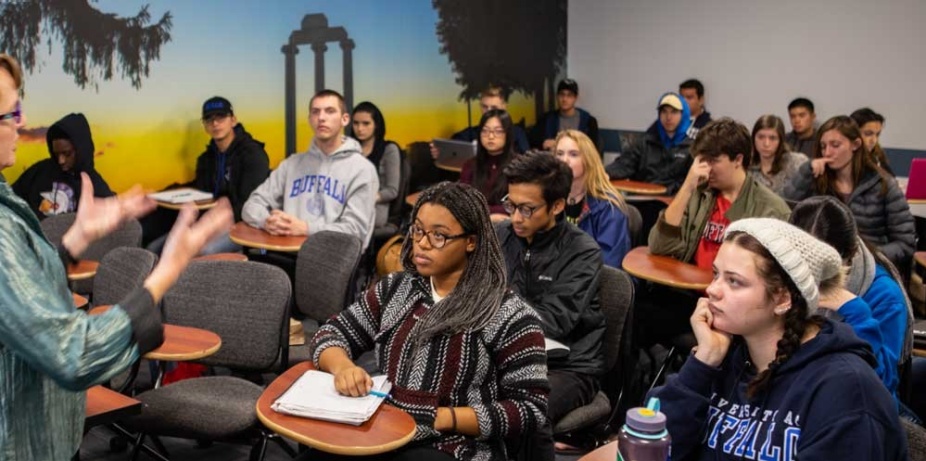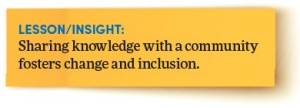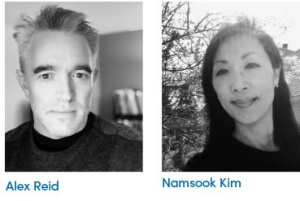

Creating inclusive curricula and awareness
BY MICHELLE KEARNS
As part of a new UB effort to help faculty reimagine their courses to include more diverse perspectives, two GSE professors shared their expertise and ideas with colleagues as one of a series of “Inclusive Pedagogy” online seminars organized by UB’s Office of Inclusive Excellence.

Raechele Pope, associate dean for faculty and student affairs, chief diversity officer and associate professor of higher education.
In their webinar, Amy Reynolds, professor in the Counseling, School and Educational Psychology Department, and Raechele Pope, associate dean for faculty and student affairs, chief diversity officer and associate professor of higher education, outlined an approach to analysis and self-reflection in teaching practices.
“Very few faculty were trained to actively address equity issues in their coursework,” said Reynolds.
She and Pope explore multicultural issues in their teaching, research and writing, and have co-authored two related books together: “Multicultural Competence in Student Affairs: Advancing Social Justice and Inclusion” and “Creating Multicultural Change on Campus.”
“Including scholars of color and other minoritized and marginalized groups and infusing cultural content and critical analysis is essential to making higher education inclusive and relevant,” said Pope. “If we are truly committed to equity, diversity, justice and inclusion, we must begin with a massive overhaul and transformation of our curriculum.”
During their spring presentation, they reviewed strategies for incorporating a more diverse point of view in every discipline—from math to the social sciences.
“Our belief is that every single class can have a diversity component, even if it’s math or science,” said Reynolds. “Every class can use a cultural lens and understanding of inclusion to better teach all of their students, not just the students that may be from minoritized or marginalized groups.”

Amy Reynolds, professor in the Counseling, School and Educational Psychology Department.

A change in teaching practices that veers away from relying on white Eurocentric perspectives is critical, they said. “All students need an expanded view of every topic area to deeply understand its impact on the world.
Getting started
To help faculty broaden the scope of their teachings, Reynolds encourages resources like francesharper.com, a website aimed at assisting math educators created by a math education professor at the University of Tennessee. The site includes problem samples that reveal social justice insights and help people consider different approaches.
Reynolds and Pope highlighted the need to include equity and diversity issues in course readings, assignments, and how student work is evaluated. For example, Reynolds explained that a diverse perspective can come through in a math word problem that asks students to calculate what hourly wage is needed for a family to afford housing in a city like Chicago.
“Then, inevitably, as you talk about that, you increase the awareness of students around social justice issues … about economic inequity,” she said. “And they begin to understand the ways in which systems are not working for everybody.”
Considering social justice issues can also improve science teaching. Pope described how using news-related illustrations, like the lead-contaminated water in Flint, Mich., helps engage students.
“So, you’re talking about science. You’re talking about biology and then you talk about providing clean, safe water for people to drink … in these communities where people have ignored it,” she said. “Those are sciencetype questions with a social justice lens or an infused lens.”
Faculty reflections

For Alex Reid, associate professor in the Media Study Department, Pope and Reynolds’ presentation was a beginning. “I thought it was a good overview of some of the challenges and where to start,” he said.
Reid, a former professor in the English department, is director of UB’s Writing Across the Curriculum program. While incorporating readings from diverse perspectives is a long-standing principle in literature courses, he is exploring how to apply that lens when teaching about media and emerging technologies.
Namsook Kim, GSE clinical assistant professor in the Department of Educational Leadership and Policy, thought of Pope and Reynolds’ presentation as an opportunity to self-reflect and ask, “Is what I am doing transformative enough?
Kim realized that inclusivity is ongoing work. As she prepares her classes, she looks for scholarship, writings and videos, from diverse sources, taking time to find the right pronouns.
“We have to do this all the time,” she said. “I am revisiting everything. Commitment is not an option. It’s a must. It is part of our professional competence.”
Next steps
This year’s webinar programming from the Office of Inclusive Excellence was part of a bigger partnership with the schools throughout the university. Efforts ranged from last year’s GSE Teach-In forum about racial equity to a School of Public Health and Health Professions workshop about creating more collaborative learning environments and increasing student contributions to coursework.
The series of six webinars averaged about 100 attendees per presentation and included topics that ranged from general approaches to curriculum change to case study consideration, anti-racist teaching practices, and how to facilitate classroom conversations about race.

Pope and Reynolds’ presentation was unique because of its specificity, said Jared Strohl, PhD ’20, diversity project coordinator for the Office of Inclusive Excellence. “They were really zooming in to the course-design aspect,” he said. “I think that was the real strength of their presentation.”
For Strohl, their focus on curriculum was particularly helpful for highlighting the importance of incorporating student insights into coursework.
“When you’re designing a course, you’re not just thinking about the material in your syllabus and the readings you have. It’s also digging a little bit deeper into, ‘How are the students themselves engaging with the course? What are the ways that you’re bringing them into the fold of the curriculum and asking them to become part of the class?’” he said. “There’s this relationshipengagement piece that I hadn’t been thinking about as holistically before.”
While the Office of Inclusive Excellence hasn’t settled on its approach for future initiatives, the website has resources culled from this year’s work, including some session recordings and strategies from UB and other institutions.
Overall, the programming was successful. Strohl expects it will inspire the planning for next year that lies ahead this summer. One of the keys to more inclusivity is the kind of community exchange that Pope and Reynolds contributed to.
“The foundation of real change comes from relationships. It comes from trust. It comes from learning from one another. It comes from talking with people who think very differently than you and maybe have had a totally different training than you,” said Strohl.
“So how to break down those barriers, the siloes that people always talk about with academia is a complicated problem, but I think that focusing on an issue like inclusive pedagogy, something that everyone who is a faculty member at UB does … that is how we’re really going to foster change.”
The above story is featured in:
Community matters. It defines who we are. It aligns with our mission as a public research university and graduate school of education. Community and its lessons strengthen academics with innovations and evidence-based practices, improve opportunities for people and spark creativity.